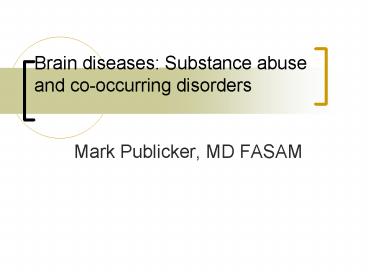Brain diseases: Substance abuse and co-occurring disorders - PowerPoint PPT Presentation
Title: Brain diseases: Substance abuse and co-occurring disorders
1
Brain diseases Substance abuse and co-occurring
disorders
- Mark Publicker, MD FASAM
2
Addiction
- A chronic but treatable brain disease
characterized by - Loss of control
- Compulsive use
- Use despite known harm
- Relapse
- The emergence of a negative affect state
3
Questions
- Does mental illness cause substance abuse?
- Does substance abuse cause mental illness?
4
Questions
- Are there differences in populations
- Primarily psychiatric
- Primarily substance dependent
5
Comorbid substance abuse
- Common problem in psychiatric patients
- Contributes to treatment failure and
non-compliance - Increased health care costs
6
Neurobiology
- Same neurotransmitter systems
- Dopamine
- Serotonin
- GABA
- Glutamate
- Endogenous opioids
7
Neurobiology
- Drugs of abuse interact and alter neural
substrates of psychiatric disorders - More neuro-psychological impairment
8
Rand Survey 2001
- 3 US population has co-occuring disorders
- Of these
- 72 received no treatment in previous 12 months
- Only 8 received both mental and substance abuse
treatment - Only 23 of those in treatment received
appropriate treatment
9
Current situation in US treatment systems
- Comorbid rates are high
- Different services are provided according to
entry portal
10
Co-morbid psychiatric disorders
- Depression
- Anxiety disorders
- Bipolar disorder
- Schizophrenia
11
Co-morbid psychiatric disorders
- Attention deficit hyperactivity disorder
- Post traumatic stress disorder
- Antisocial personality disorder
12
Epidemiology substance abuse disorders
- 50 lifetime prevalence for psychiatric patients
- Among individuals with alcohol use disorders,
about 22 will also have a drug use disorder - Among individuals with a drug use disorder,
almost half (47) will have an alcohol use
disorder - Schizophrenia 70prevalence rates
- Earlier onset of symptoms
13
Epidemiology
- Affective disorders are very common. Up to 67 of
alcohol-dependent patients, 53 of
cocaine-dependent patients, and 75 of
opiate-dependent patients have comorbid affective
disorders - Approximately 25-50 of alcohol dependent
individuals meet criteria for an anxiety disorder - Approximately 30-60 of patients with an SUD have
comorbid Antisocial Personality Disorder
14
14
15
Order of Onset
- Mental disorders typically emerge before comorbid
substance use disorders - This pattern is somewhat stronger for women than
men - Data from a large epidemiologic study found that
the median age of onset of mental disorders was
11 yrs old as compared to 21 yrs old for
substance disorder
15
16
Diagnostic Difficulties
- Substance intoxication and withdrawal can mimic
nearly any psychiatric disorder - Stimulants/hallucinogens/cannabinoids mania and
schizophrenia - Alcohol/opiate/sedative-hypnotic withdrawal
- depressive and anxiety disorder
16
17
Diagnostic Difficulties
- Assess which disorder developed first
- Ask about symptoms during periods of abstinence.
Minimum acceptable period of abstinence necessary
for diagnostic clarity will differ by diagnosis - Anxiety/depression most symptom overlap, 2-4
weeks important. - Psychosis/mania 2-4 days sufficient in most
cases. - Ask about family history
- Consult multiple sources of information
18
Substance Use and Suicide
- Substance induced depression
- May resolve quickly with treatment but is still
very dangerous - Increased suicidal thoughts, ideation
- High risk group Diagnosis of major depression
alcohol or drug abuse/dependence - Rates are 20-120X the general population
19
Epidemiology
- Schizophrenia substance abuse associated with
higher rates of homelessness, non-compliance,
medical illness and violence - Bipolar disorder rates estimated to be 50-70
- Associated with worse prognosis
20
Epidemiology
- Unipolar depression 30-50
- Associated with treatment resistance and greater
severity - Worsens alcohol dependence treatment outcomes
21
Epidemiology
- ADHD 50 of substance abuse patients
- Increases risk of substance abuse
- Effective childhood treatment reduces risk
22
Epidemiology
- PTSD increased risk of substance abuse
- Hypothalamic and noradrenergic mechanisms
- Substance abuse increases PTSD symptoms which in
turn intensify substance abuse
23
Post traumatic stress disorder
- Withdrawal symptoms overlap with arousal symptoms
- Increased stress sensitizes the Locus Ceruleus
24
Post traumatic stress disorder
- Increased noradrenaline increases stress
- Increased fear responses in amygdala
25
Epidemiology - Nicotine
- Nicotine-dependent patients with comorbid
disorders 7.1 US population consume 34.2 of
all cigarettes smoked
26
Self-medication hypothesis
- Nicotine decreases stress reactivity
- Schizophrenia nicotine used to deal with
negative symptoms - Sleepiness
- Dysphoria
- Antipsychotic adverse effects
- Improve cognitive function
27
Cannabis
- Heavy adolescent use increases psychiatric risk
- Depression
- Anxiety disorders
- Schizophrenia
28
Summary
- High rates of comorbidity
- Each increases the risk of the other and
complicates their management - Concurrent treatment yields best results































